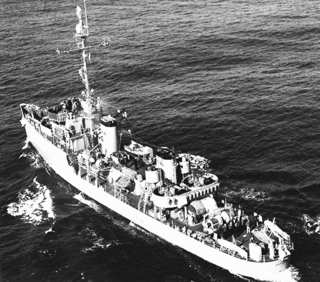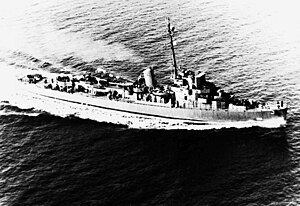
USS Ralph Talbot (DD-390) was a Bagley-class destroyer in the United States Navy, named for USMC Second Lieutenant Ralph Talbot (1897–1918), who was awarded the Medal of Honor during World War I. Talbot served in the Pacific Theater during World War II, from the attack on Pearl Harbor through the battle of Okinawa, earning 14 battle stars for her service.

USS O'Flaherty (DE-340) was a John C. Butler-class destroyer escort built for the United States Navy during World War II. She was named for Ensign Frank Woodrow O'Flaherty, a pilot who posthumously received the Navy Cross for his actions at the Battle of Midway.

USS Stafford (DE-411) was a John C. Butler-class destroyer escort in the United States Navy. She was named after Richard Y. Stafford (1916–1942), a United States Marine Corps Captain who died during the Battle of Guadalcanal.

USS Evans (DD-552), a Fletcher-class destroyer, was the second ship of the United States Navy to be named for Rear Admiral Robley D. Evans (1846–1912).

USS Stanly (DD-478) was a Fletcher-class destroyer in service with the United States Navy from 1942 to 1947. She was scrapped in 1972.

USS Anthony (DD-515), a Fletcher-class destroyer, was the second ship of the United States Navy to be named for Marine Sergeant Major William Anthony (1853–1899).

USS Capps (DD-550), a Fletcher-class destroyer, was a ship of the United States Navy named for Rear Admiral Washington L. Capps (1864–1935).

USS Haggard (DD-555) was a Fletcher-class destroyer of the United States Navy named for Captain Haggard of the Louisa, who fought in the Quasi-War.

USS Defense (AM-317) was an Auk-class minesweeper acquired by the United States Navy for the dangerous task of removing mines from minefields laid in the water to prevent ships from passing.

USS Porterfield (DD-682) was a Fletcher-class destroyer of the United States Navy. She was laid down by the Bethlehem Shipbuilding, San Pedro, California 12 December 1942; launched 13 June 1943; sponsored by Mrs Louis B. Porterfield and commissioned 30 October 1943, with Commander J. C. Woefel in command.

USS Fair (DE-35) was an Evarts-class destroyer escort of the United States Navy.

USS Halloran (DE-305) was a Evarts-class destroyer escort of the United States Navy.

The second USS Fleming (DE-32), and first ship of the name to enter service, was an Evarts-class destroyer escort built for the United States Navy during World War II. While performing convoy and escort duty in the Pacific Ocean she was also able to sink one Japanese submarine and to shoot down several kamikaze planes that intended to crash onto her. For her military prowess under battle conditions, she was awarded four battle stars.

USS Sederstrom (DE-31) was a Evarts-class destroyer escort of the United States Navy during World War II. She was promptly sent to the Pacific Ocean to escort convoys and to protect other ships from Japanese planes and submarines. Her assignments took her from one battle area to another, but she was fortunate in remaining almost unscathed by the end of the war. For her efforts in battle areas, she was awarded five battle stars by war's end.

The second USS Tisdale (DE-33) was an Evarts-class destroyer escort of the United States Navy during World War II. She was promptly sent off into the Pacific Ocean to protect convoys and other ships from Japanese submarines and fighter aircraft. She performed dangerous work in numerous battle areas, and was awarded four battle stars.

USS Wesson (DE-184) was a Cannon-class destroyer escort built for the United States Navy during World War II. She served in the Pacific Ocean and provided escort service against submarine and air attack for Navy vessels and convoys. She returned home at war's end with a very respectable seven battle stars to her credit.

USS Oliver Mitchell (DE-417) was a John C. Butler-class destroyer escort built for the United States Navy during World War II. Post-war, after active participation in the Pacific War, her crew returned home with five battle stars to their credit.

USS Howard F. Clark (DE-533) was a John C. Butler-class destroyer escort in service with the United States Navy from 1944 to 1946. She was sold for scrapping in 1973.

USS Silverstein (DE-534) was a John C. Butler-class destroyer escort in service with the United States Navy from 1944 to 1947 and from 1951 to 1958. She was sold for scrapping in 1973.

USS William C. Cole (DE-641) was a Buckley-class destroyer escort of the United States Navy, named in honor of Vice Admiral William C. Cole (1868–1935).





















